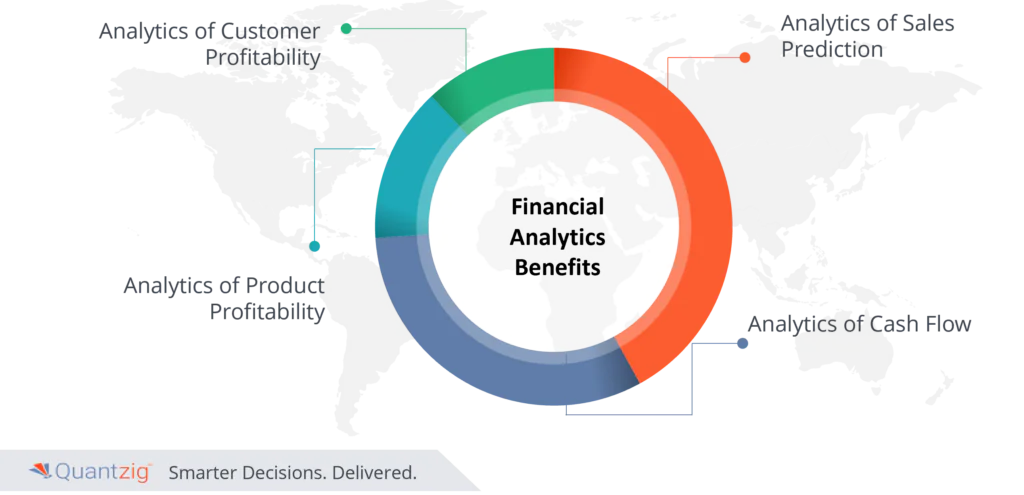Financial Analytics in the Digital Era: Navigating the Future of Business Intelligence
In the fast-paced and ever-evolving business landscape of 2025, financial analytics has emerged as a cornerstone for organizations striving to maintain competitiveness, ensure profitability, and make informed strategic decisions. As digital transformation accelerates, the integration of advanced financial services analytics into financial operations is no longer optional but imperative. This comprehensive exploration delves into the multifaceted role of financial analytics in the digital era, highlighting its significance, benefits of financial analytics, and real-world applications.
Table of Contents
Understanding Financial Analytics
Financial analytics encompasses the systematic use of data analysis techniques to assess and interpret financial data, enabling organizations to make informed decisions. It involves the application of statistical methods, predictive modeling, and data visualization tools to understand past performance, identify trends, and forecast future financial outcomes. By leveraging financial services analytics, businesses can gain deeper insights into their financial health, optimize resource allocation, and mitigate risks.
The Importance of Financial Analytics in 2025
The significance of financial services analytics in today’s business environment cannot be overstated. Several factors underscore its importance:
- Data-Driven Decision Making: Financial analytics empowers organizations to base their decisions on empirical data rather than intuition, leading to more accurate and reliable outcomes.
- Enhanced Forecasting Accuracy: By analyzing historical data and identifying patterns, financial analytics improves the accuracy of financial forecasts, aiding in better planning and resource allocation.
- Risk Management: Advanced analytics tools help in identifying potential financial risks and developing strategies to mitigate them, ensuring organizational stability.
- Operational Efficiency: Automation of financial processes through analytics reduces manual errors, streamlines operations, and frees up resources for strategic initiatives.
- Regulatory Compliance: Financial analytics aids in ensuring compliance with ever-evolving financial regulations by providing transparent and auditable data trails.
Core Benefits of Financial Analytics
- Customer Profitability Analysis
Financial analytics allows organizations to differentiate between high-value and low-value customers, enabling targeted strategies that enhance profitability. By analyzing purchasing behavior, customer lifetime value, and associated costs, businesses can tailor their offerings to meet the needs of their most profitable customers. - Sales Prediction Analytics
Predictive analytics plays a pivotal role in sales forecasting by analyzing historical sales data, market trends, and external factors. This foresight allows businesses to anticipate demand fluctuations, optimize inventory levels, and align sales strategies accordingly. In 2025, the integration of AI and machine learning algorithms has further refined the accuracy of sales predictions, providing businesses with a competitive edge. - Product Profitability Analysis
Determining the profitability of individual products is essential for effective product portfolio management. Financial analytics tools enable businesses to assess the direct and indirect costs associated with each product, evaluate their contribution to overall profitability, and make informed decisions regarding product development, pricing, and discontinuation. - Cash Flow Analytics
Maintaining healthy cash flow is vital for business sustainability. Financial analytics provides real-time insights into cash inflows and outflows, allowing organizations to manage liquidity effectively. Advanced forecasting models, powered by AI, enable businesses to predict cash flow trends, identify potential shortfalls, and take proactive measures to ensure financial stability.
Financial Analytics in the Digital Era
Today, analytics has become an essential component for businesses and organizations to stay competitive and relevant. Financial analytics helps businesses understand and interpret their current and past performance, and predict future performance to make better business decisions. Financial analytics software helps in speeding up the creation of reports and enables data presentation through graphs, which are much easier to read and comprehend.
Financial Analytics Benefits

1. Analytics of Customer Profitability
Customer profitability is a method to differentiate between customers that help a business make money viz-a-viz those who cause loss of money. It works on the 80/20 rule which means that 20% of customers cause 80% of the profit and 20% of customers are responsible for 80% of the customer-related costs. It is very important to understand which customer falls into which category. By understanding customer profitability, it becomes easy to extract useful insights from each group of customers.
2. Analytics of Sales Prediction
Predictive sales analytics helps in figuring out the success rate of sales forecasting. This can further help you in improving sales predictions. Sales predictions can be done in several ways like analyzing past trends or analyzing the correlations. Predictive analysis helps you sail through the peaks and troughs of your business.
Contact us to know more about financial analytics and how it can benefit your organization.
3. Analytics of Product Profitability
To stay in the competition, it is very important for the business to locate the area of its profit and loss. Product profitability is a financial analytics tool that paves the way to discover the profitability of an individual product. Which product or service is bringing you revenues is what product profitability analyzes. It is an excellent tool to gain insights across a range of products and to boost profits with time.
4. Analytics of Cash Flow
To have an eye on the health of your business, it is very important to have an eagle’s eye on the movement of cash in your business. Cash flow analytics uses real-time or retrospective indicators like working capital ratio and the cycle of cash conversion. Consequently, cost flow analytics also helps you keep turning the cogs and increase the flow of cash by prioritizing the needs of customers.
Real-World Applications and Case Studies
Euroclear and Microsoft Partnership
In a significant move towards digital transformation, Euroclear has partnered with Microsoft to modernize its financial market infrastructure. This collaboration aims to enhance operational resilience and client engagement by integrating cloud computing, generative AI, and analytics tools into Euroclear’s platform. The initiative underscores the growing importance of technological partnerships in advancing financial services analytics capabilities.
Procter & Gamble’s Supply Chain Resilience
Procter & Gamble (P&G) has leveraged financial services analytics to enhance its supply chain resilience. By utilizing digital twin technology and predictive analytics, P&G can simulate various supply chain scenarios, anticipate disruptions, and optimize inventory management. This approach ensures operational efficiency, even in the face of unforeseen challenges.
Reddit and Intercontinental Exchange Collaboration
Reddit has teamed up with the Intercontinental Exchange to develop financial data and analytics products utilizing Reddit’s user-generated content. This innovative partnership aims to provide valuable insights for financial professionals by analyzing trends and sentiments from Reddit’s extensive user base, highlighting the role of social media data in financial services analytics.
Conclusion
Conclusion
Financial analytics stands at the forefront of business intelligence in 2025, offering organizations the tools and insights necessary to thrive in a data-driven world. By harnessing the power of advanced analytics, businesses can enhance decision-making, optimize financial performance, and ensure sustainability. As technology continues to evolve, the integration of innovative analytical tools will be crucial in shaping the future of financial management. Embracing these advancements will empower organizations to not only adapt to changes but also to lead in the dynamic business environment of the digital era.



